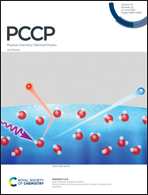Electropolymerization of EDOT in an anionic surfactant-stabilized hydrophobic ionic liquid-based microemulsion
Abstract
Here, an anionic surfactant [AOT]− (bis-(2-ethylhexyl) sulfosuccinate)-stabilized H2O/[Omim][PF6] (1-octyl-3-methylimidazolium hexafluorophosphate) microemulsion has been tested for the first time as a medium for the electropolymerization of 3,4-ethylenedioxythiophene (EDOT). To formulate AOT-stabilized [Omim][PF6]-based microemulsions of different water contents, the phase triangle was determined at 35 °C. Measurements of the conductivities of the microemulsions, their solubilization capacities toward EDOT and their catalytic effects on EDOT electrooxidation show that the present [AOT]−-stabilized ionic liquid microemulsion is a good medium for EDOT electropolymerization. Studies on the process of the electropolymerization of EDOT in this [Omim][PF6]-based microemulsion indicate that the water content (i.e., microstructure) of the microemulsion medium is an important factor affecting the onset potential and the deposition rate of the PEDOT. The morphology and the doping level of the as-prepared PEDOT are also found to be correlated with the water content of the ionic liquid microemulsion. The microemulsion with higher water content results in a PEDOT with better electroactivity and higher doping levels. FTIR spectra and XPS analysis show that the PEDOT electrosynthesized in the microemulsion is co-doped by both [AOT]− and [PF6]−. Compared with the neat [Omim][PF6], the use of the ionic liquid microemulsions can reduce not only the consumption of the expensive ionic liquid, but also the onset potential for the electrooxidation of EDOT. Moreover, by tuning the water content of the medium, the electropolymerization of PEDOT and its electrochemical properties could be regulated accordingly. Under the identical deposited charge, the PEDOT originated from the high water content microemulsion (50% H2O μE) has a higher specific capacitance (124 F g−1) than that from neat [Omim][PF6] (117 F g−1). It follows that the present ionic liquid microemulsion is a good medium for EDOT electropolymerization. The present study opens up a new route for the green and low-cost electrochemical preparation of high-performance PEDOT.



 Please wait while we load your content...
Please wait while we load your content...